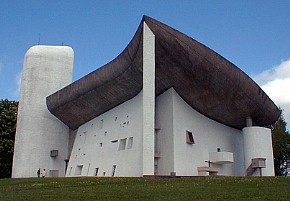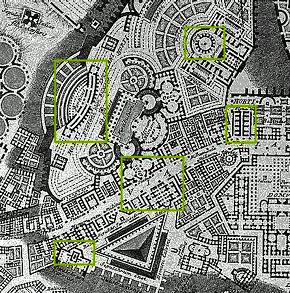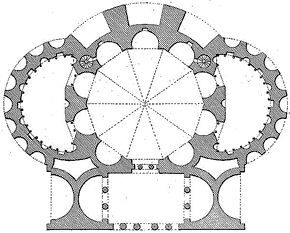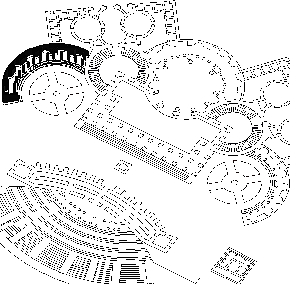2005.05.09 09:45
Koolhaas versus the Actor
I too am interested in this discussion. In fact, you're the first person to discuss Tafuri vis-a-vis the Campo Marzio with me online, and I appreciate your knowledge of the subject.
For the sake of clarity, I wish to restate my argument(s).
1. Manfredo Tafuri is no authority when it comes to Piranesi's Ichnographia Campi Martii.
2. Tafuri no where demonstrates an understanding of reenactment as it relates to the generation and history of architectural design.
3. It is many times more valuable to reenact architectures than it is to reenact architectural critics/historians.
=====
Yesterday, I re-read Eisenman's "The Wicked Critic" (in ANY 26, February 2000), and as far as Piranesi's Campo Marzio is concerned, Eisenman only continues to reiterate Tafuri's mistakes. Eisenman does, however, mention that Piranesi moved some building locations within the Campo Marzio plan, and up to that point I/Quondam are the only published sources of that type of information, so Eisenman is not altogether disclosing of where he gets some of his information. This relates to the issue of texts/data published online in that such publications should rightly be referenced (at least footnoted).
David R. Marshall in "Piranesi, Javarra, and the Triumphal Bridge Tradition" (The Art Bulletin, June 2003) also relates information regarding the Campo Marzio plan, that prior was only available at Quondam, without giving the reference a proper citing.
Hani Rashid is likewise guilty of the same inaction...
As far as I'm concerned, architectural academia isn't necessarily all that trustworthy.
2005.11.10 10:38
It rocked Eisenman in his chair...
My opinion of Bloomer's book, as far as it relates specifically to reading Piranesi's Ichnographia of the Campo Marzio, is that it is indeed wrong and [somewhat] trite--almost all of what Bloomer writes about the Ichnographia is taken virtually verbatim from Tafuri; she does, however, include some original material relative to the "pit of the underworld" citing it as the entry way into understanding the Ichnographia as a labyrinth, but she misses the real key to the large plan (the tiny intercourse building) which is directly across the Tiber from the pit. Bloomer's book may be fun, but it is not good scholarship in that she really did not come to read and understand the whole plan at all--she went on to seek meaning "underneath" the plan while what she really did was avoid the actual plan itself. Can you honestly say that you now know what the Ichnographia is about after reading Bloomer's book?
2005.11.10 15:03
It rocked Eisenman in his chair...
To be honest, I care very little about what Bloomer wrote or how she intellectually operates. What I do care about is what Piranesi delineated via the two versions of the Ichnographia of Il Campo Marzio.... All I have ever done is analyze the Ichnographia itself, which is exactly what virtually all other contemporary writers on the Ichnographia have not done! I have never been interested in spreading some current/trendy intellectual "thought" by troping Piranesi and the Ichnographia, a course of action begun by Tafuri. What I am interested in is to find out what Piranesi did himself.
| |
2006.01.18 17:39
what is the good source to study folding architecture?
….when it really comes down to an architectural design, folding architecture really does boil down to what it looks like. So, as far as I'm concerned, folding architecture is just another form, in the long history of forms, that architecture can take on, and, like jlxarchitect says, "if it can solve my office's project's problem, then it is OK to use."
Otherwise, the notion of "an entire school of [failed?] thought" is stillborn, rather than being something within the evolutionary continuum of architectural design. And just because it's what is taught in school doesn't necessarily make it the truth. For example, the "Metabolist" architects of Japan talked a lot about architecture reflecting "life giving" forms, while at the same time appearing oblivious to the fact that metabolism as a operation is a creative/destructive duality. Likewise, everything Tafuri and Eisenman said/say about Piranesi's Ichnographia Campus Martius is just plain incorrect, yet their mistakes are taught and published over and over again.
2006.03.03 11:27
I want to write about architecture....How?
Ah, the design of a banquet...
A Preprandial Aperitif
Cucumber Slices, Caviar and 'Sociables' Crackers
Spinach and Mushroom Salad
A Glass of Blue Nun Wine
Sketches cum Napkins
A Trip to the Rest Room
Coquille St. Jacques
Pears Helene
The Speeches
Dried Fruit and Nuts
Australian Port and a Cigarette
The Ride Home
Plop Plop Fizz Fizz
I wonder how many others have figured out that the title of QBVS was initially inspired as antidote to Tafuri's "we end up with a kind of typological negation, an "architectural banquet of nausea," a semantic void created by an excess of visual noise."
2006.06.15 13:30
UPenn M.Arch Summer Reading List
Using the Kwinter quotation, "the effect of unforeseeable complexity that arises from multiple interfering structures blindly pursuing their own clockwork logic," as a case in point, one only has to compare it to the following Tafuri quotation, "The clash of the formal organisms, immersed in a sea of formal fragments, dissolves even the remotest memory of the city as a place of Form, and the whole organism seems to be a clockwork mechanism."
2007.03.28 15:18
Theory Part II - Doing What I Said I Would Do...
If anyone here thinks that I am opposed to or think lowly of "getting ideas from misreading a text," then you have jumped to a wrong conclusion.
What I do find fault in is Tafuri's interpretation of Piranesi's Campo Marzio. And since this faulty interpretation is a crucial element of Tafuri's "historical-critical project"/research, I then see the need to re-evaluate Tafuri's overall theory. Moreover, that what Piranesi actually did with the Campo Marzio is indeed the opposite of Tafuri's interpretation of what Piranesi did with the Campo Marzio can well suggest that Piranesi's Campo Marzio shouldn't even be within Tafuri's overall theory.
And then there is Peter Eisenman utilizing and teaching Piranesi's Campo Marzio based on (really just repeating) Tafuri's misinterpretation of Piranesi's Campo Marzio. Furthermore, Eisenman has not contributed any new insight regarding Piranesi's Campo Marzio, and, if anything, more just tailors Tafuri's misinterpretation to suit his own design methodology. What I see fault in here is Eisenman's suggestion that his method is based on what Piranesi did within the Campo Marzio, where, in fact, Eisenman's method is based on Tafuri's misinterpretation of what Piranesi did. Again, it is more the case that what Piranesi did within the Campo Marzio has very little to do with Eisenman's method.
| |
2007.03.28 16:17
Theory Part II - Doing What I Said I Would Do...
Eisenman doesn't misread Tafuri at all. And judging by Tafuri's interpretation, he didn't even bother to read Piranesi's Latin labels within the Ichnographia Campi Martii. Misreading [Piranesi] isn't even the issue here. It's more the lack of reading [Piranesi] altogether.
2008.10.19
chapters of AinCC
1. [sic]
2. To ERr with SuperGlue(TM)
3. Bilocation Syndrome
4. Going into Eclectic Shock
5. Surgical Double Theater
6. Waiting Room: Anxious, Reading, Liszt
7. Operation a Sucess; Patient Dead
8. Malpractice Case: House
9. Eternal Wrest
For [sic] I can collect all the various mistakes I've found over the years, starting with Immacualte Conception. It would be possible to limit the chapter to this material. I'll know better once the bulk of the material has been collected.
To ERr w/SG could be the whole Eisenman as Piranesi expose and an unraveling (somewhat) of Tafuri's interpretation (of the Campo Marzio). The missing notion of reenactment within "dans le boudoir" could happen here.
Bilocation Syndrom could be all about IQ and how it operates. Perhaps including thoughts on virtual and real and how there can be two places where things occur (simultaneously?).
My thoughts for Eclectic Shock were all about the recombinant architectures stuff. I suppose that's the point, but I'd like good shock to be involved as well.
Right now I have no idea what "surgical double theater" is really about. I suppose I could go through TX2 and TX2, too for further ideas and hope that that's enough. The surgical aspect may occur in cutting the various double theaters open and thus finding new meaning, inspiration, modus operandi, etc. I could take all the sic items and operate on them, but not ultimately be able to fix it all.
"Waiting Room: Anxious, Reading, Liszt" could have something to do with copyright-free texts and altered texts and lots, lots of them--the wordiest chapter of the book that doesn't really have to mean anything. (At this point I got Encyclopedia Britannica to read about Liszt.)
Anthony Vidler, "Postmodern or Posthistoire?" in Histories of the Immediate Present: Inventing Architectural Modernism (Cambridge, MA: The MIT Press, 2008), pp. 191-200.
4713
2010.10.15 15:39
Can Someone Explain the Meaning of Projective Practice?
"To understand what exactly is meant by these terms hermeneutic and material practice it is perhaps more interesting if we compare them with a third term 'projective practice' which aims at a very similar redefinition of practice and places these 'redefinitions' in the context of the current debate described earlier. The term 'projective' is put forward in the article 'Notes around the Doppler Effect and other Moods of Modernism' by Robert Somol and Sarah Whiting. When Somol & Whiting introduce the term 'projective'. They also address the problem of the theory-practice distinction but in a far more indirect way, in their argument these are still very much intertwined. The article starts off with the heading "from critical to projective". This needs some further explanation. . ."
Edwin Gardner, 2010.10.12
Lots of similar articles all over the web.
I remember enjoying Aureli and Orazi's "The Solitude of the Project" and maybe this time I'll again finish Tafuri's "The Historical 'Project'".
As to definitions, this is my favorite:
projective 1 b : not metrical : not involving size and measurment but only relative position, incidences, and coincidences
especially the coincidences.
Like I've already said, all the world's a next stage.
| |
2011.01.04 21:18
Bilocation Syndrome
It's very strange for Meier to say he was involved with Roma Interrotta when in fact he was not one of the 12 architects involved with Roma Interrotta.
Plus, the Whites vs. Grays 'debate' was a mid-seventies thing. There is even an A+U magazine from 1975 or 1976 with the whole theme of Whites vs. Grays. Not to mention Tafuri's "American Graffiti: Five x Five = Twenty-five" in Oppositions 5 (Summer 1976) -- "Tafuri maintains that, notwithstanding the hermetic polemics of "Grey" versus "White"..."
2011.10.01 09:35
Did deconstruction turn into blobitecture some time in the 90's?

"freedom from both recognized typology and recognized construction industry standards / techniques."
"...heed Tafuri's warning that "once the 'form is made free', the geometric universe becomes an uncontrollable 'adventure." (see Tafuri's "European Graffiti." Five x Five = Twenty-five, 1976.)
2011.11.07 10:25
Quondam's Fifteenth Anniversary
"The compositional innovation manifests itself further with rich resources in the Burial Place of the Augustan family ("Bustum Caesaris Augusti") and the Gardens of Lucilian ("Horti Luciliani")."
--Vincenzo Fasolo, "The Campo Marzio of G. B. Piranesi" by Vincenzo Fasolo first appeared in Quaderni dell'Instituto di Storia dell'Architecttura, n.15 - 1956, published by the Faculty of Architecture at the University of Rome.
Fasolo's essay on Piranesi's Ichnographia of the Campo Marzio is relatively rare among Campo Marzio literature in that it presents a straightforward description and analysis of Piranesi's urban design, yet it nonetheless harbors factual errors and misinterpretations. This essay also formed the groundwork of Tafuri's later interpretation of Piranesi's large plan.

5. Above all, the nymphaeum of the Orti Liciniani, then and still known as the temple of Minerva Medica. Alberti's inclusion of the decagon among his shapes for churches is, no doubt, due to this prototype.
--Rudolf Wittkower, Architectural Principles in the Age of Humanism (1962), p. 5.
| |

"...finally, the group dominated by the Bustum Caesaris Augusti, an imposing collection of regular and irregular geometric forms one grafted on to the other according to the law of opposition. (Attention is also called, in passing, to the appearance of two phallic-shaped planimetric organisms converging on the hexagonal atrium, which foreshadow, perhaps with no other intent than a pure ludus geometrico, the project of Ledoux's Oikema and some of Soane's typological notions.)
But it is in the Horti Luciliani that the mechanical architecture of Piranesi reaches an extreme level of abstraction. Here, a complex of structures in semicircles and in sectors of circles obeys the rule of gemmation, as they revolve around the Atrium Minervae: an astonishing mechanism, in which Piranesi achieves the maximum refinement of his geometric instruments."
--Manfredo Tafuri, The Sphere and the Labyrinth - Avant-Gardes and Architecture from Piranesi to the 1970s (Cambridge: The MIT Press, 1987), p.36.

1998.04.29
The other discovery deals with the horti Luciliani and the horti Lucullani.
Piranesi places the fictitious horti Luciliani where the horti Lucullani ought to be, and places the horti Lucullani at a location further north. It is the horti Lucullani that Messalena murdered for.
Lucilius is the father of Roman satire. Is there anything satirical in Piranesi's plan of the garden? Perhaps the answer has something to do with a shrine to Minerva being in the center of one of the building complexes--literally "wisdom" (but also "weaving") in the center of a garden of satire. The theater and salons, now make more sense.
satire 1 a : an ancient Roman commentary in verse on some prevailing vise of folly b : a usually topical literay composition holding up human or individual vices, folly, abuses, or shortcomings to censure by means of ridicule, derision, burlesque, irony, or other method sometimes with an intent to bring about c : LAMPOON 2 a : a branch of literature ridiculing vice or folly
censure 1 : a judgement involving condem-nation a : spiritual chastizement by an ecclesiastical agency
wit implies intellectual brilliance and quickness in perception combined with a gift for expressing ideas in an entertaining, often laughter provoking, pointed way, usually connoting the unexpected or apt turn of phrase or idea and often suggesting a certain brittle unfeelingness
satire can apply to any criticism or censure relying on exposure, often by irony and often subtle, of the ridiclous or absurd qualities of something
The notion of Piranesi being satirical himself throughout the Ichnographia is an intriguing idea.
...the various other gardens and buildings that Piranesi places on the same plateau as the horti Lucullani. Some of them, like the horti Narcissi, relate directly to the Messalena story since it is the freedman Narcissus that ultimately kills Messalena. There is also the horti Anteri--Anteros means "an avenger of slighted love," which describes both Messalena and her husband the emperor Claudius, although for different reasons.
...Tafuri could have said so much more about the horti Luciliani.
|